Performance Improvement Review Report: Construction Industry
VerifiedAdded on 2022/11/18
|28
|9124
|346
Report
AI Summary
This report provides a comprehensive analysis of the UK construction industry, focusing on its structure and the relationships between various companies. It explores the tendering process, different types of contractual work, and the evolution of company structures, including the roles of professionals and technicians. The report delves into the development of construction companies, their business ethos, and the ethical considerations within the industry. It also examines modern construction processes, sequences, and the impact of BIM (Building Information Modeling), highlighting sustainability aspects. Furthermore, the report addresses health and safety integration, government legislation, and the importance of collaboration and communication in ensuring safe working practices. The analysis covers various aspects of the construction industry, providing insights into its development, challenges, and future directions.
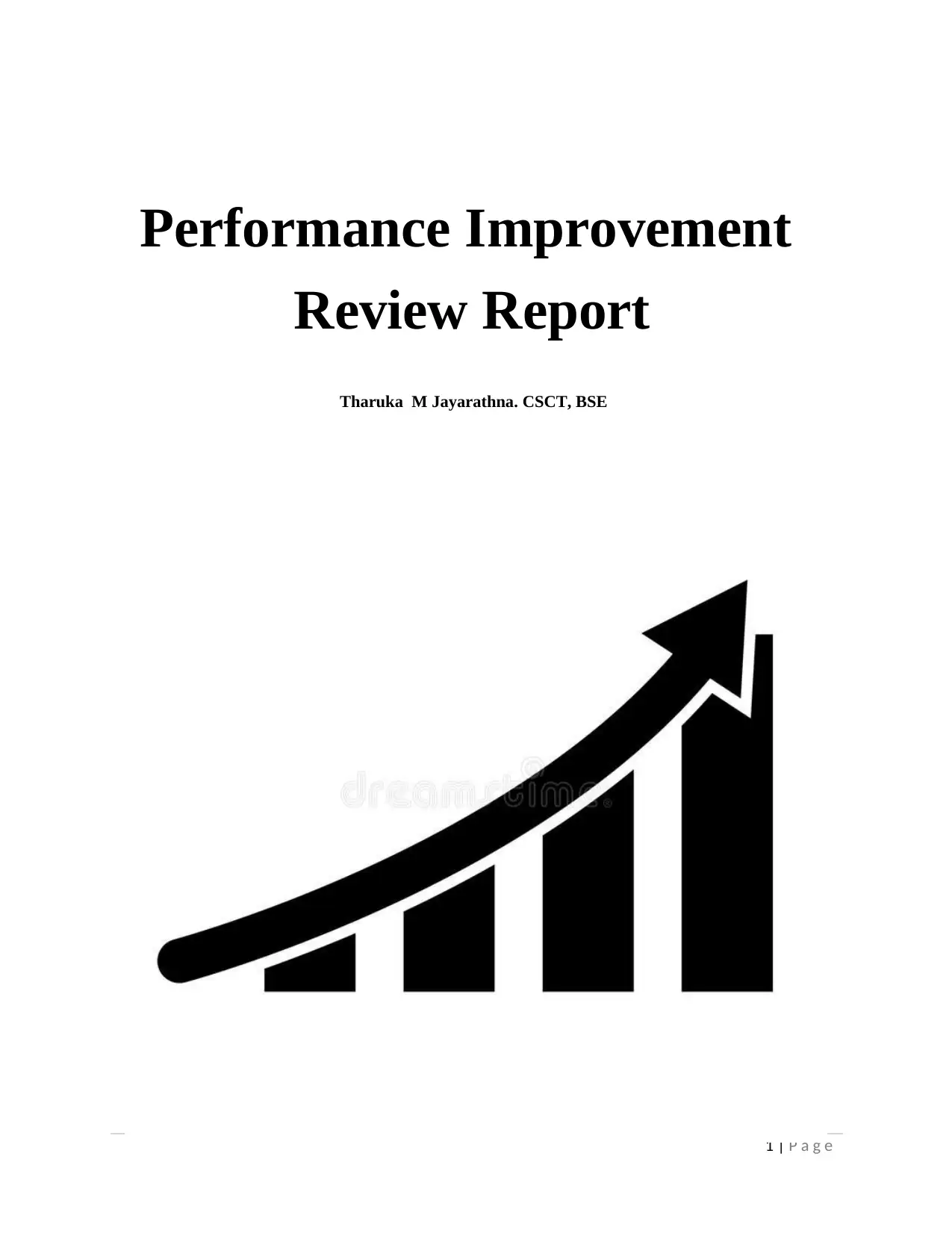
1 | P a g e
Performance Improvement
Review Report
Tharuka M Jayarathna. CSCT, BSE
Performance Improvement
Review Report
Tharuka M Jayarathna. CSCT, BSE
Paraphrase This Document
Need a fresh take? Get an instant paraphrase of this document with our AI Paraphraser
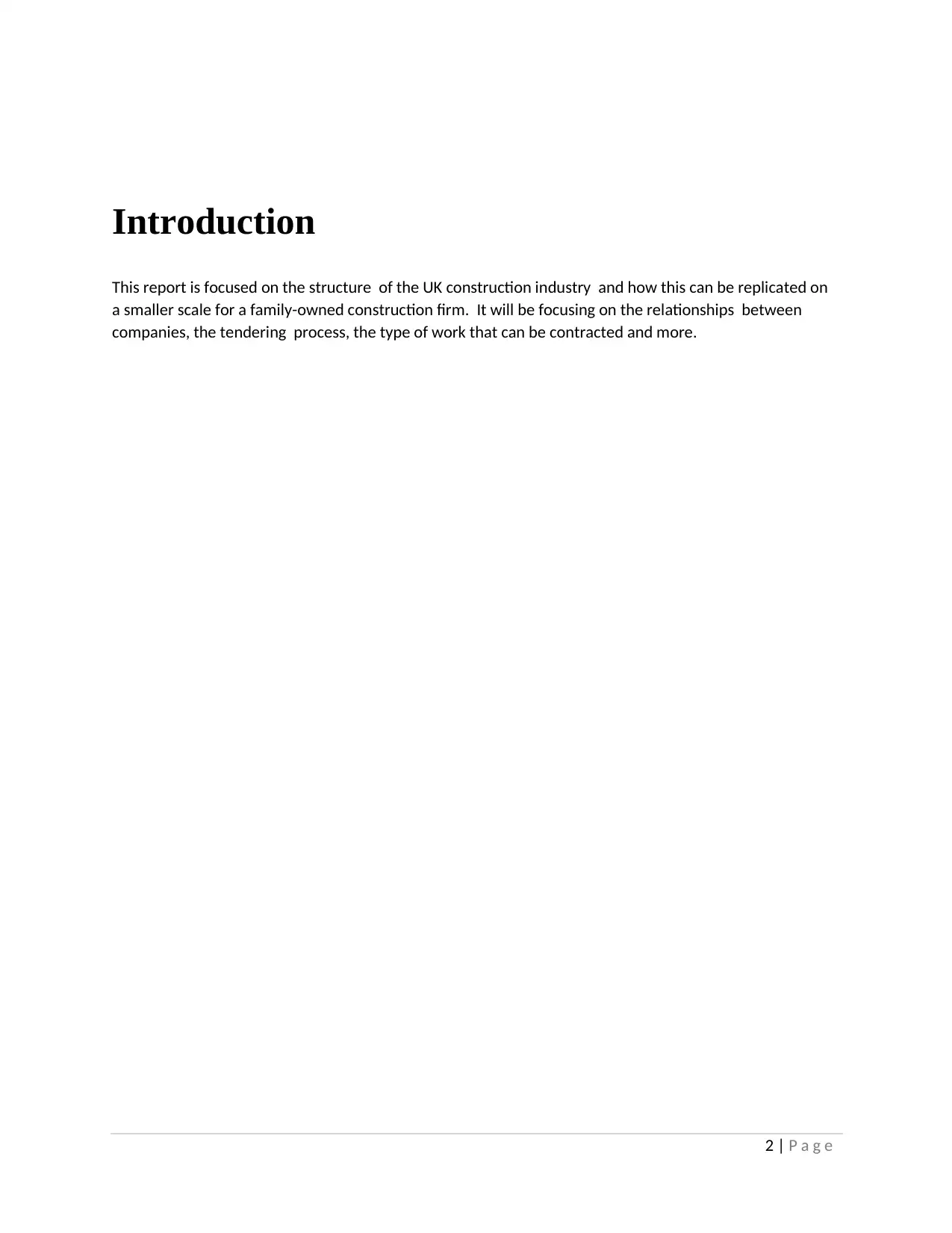
2 | P a g e
Introduction
This report is focused on the structure of the UK construction industry and how this can be replicated on
a smaller scale for a family-owned construction firm. It will be focusing on the relationships between
companies, the tendering process, the type of work that can be contracted and more.
Introduction
This report is focused on the structure of the UK construction industry and how this can be replicated on
a smaller scale for a family-owned construction firm. It will be focusing on the relationships between
companies, the tendering process, the type of work that can be contracted and more.
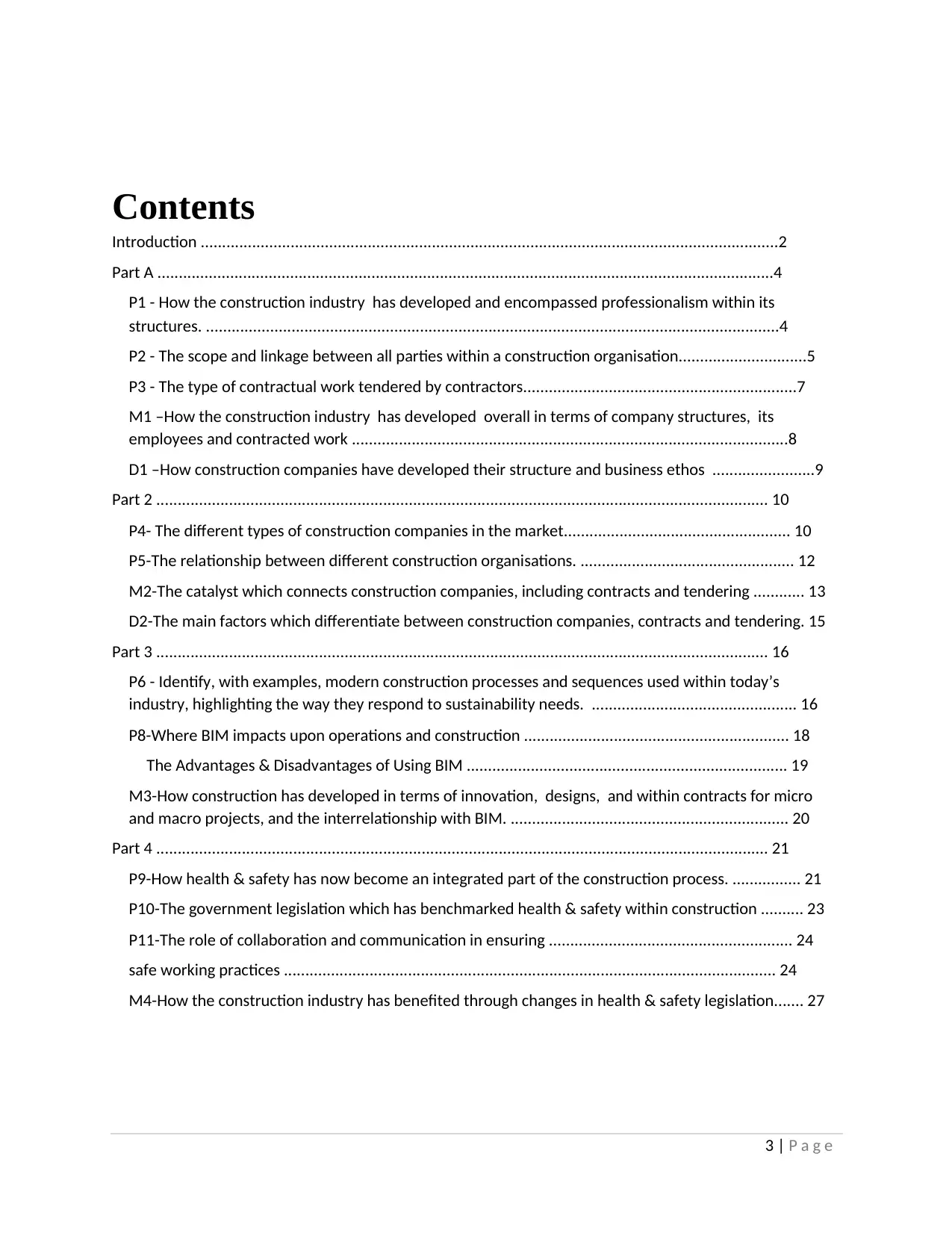
3 | P a g e
Contents
Introduction .......................................................................................................................................2
Part A ................................................................................................................................................4
P1 - How the construction industry has developed and encompassed professionalism within its
structures. ......................................................................................................................................4
P2 - The scope and linkage between all parties within a construction organisation..............................5
P3 - The type of contractual work tendered by contractors................................................................7
M1 –How the construction industry has developed overall in terms of company structures, its
employees and contracted work ......................................................................................................8
D1 –How construction companies have developed their structure and business ethos ........................9
Part 2 ............................................................................................................................................... 10
P4- The different types of construction companies in the market..................................................... 10
P5-The relationship between different construction organisations. .................................................. 12
M2-The catalyst which connects construction companies, including contracts and tendering ............ 13
D2-The main factors which differentiate between construction companies, contracts and tendering. 15
Part 3 ............................................................................................................................................... 16
P6 - Identify, with examples, modern construction processes and sequences used within today’s
industry, highlighting the way they respond to sustainability needs. ................................................ 16
P8-Where BIM impacts upon operations and construction .............................................................. 18
The Advantages & Disadvantages of Using BIM ........................................................................... 19
M3-How construction has developed in terms of innovation, designs, and within contracts for micro
and macro projects, and the interrelationship with BIM. ................................................................. 20
Part 4 ............................................................................................................................................... 21
P9-How health & safety has now become an integrated part of the construction process. ................ 21
P10-The government legislation which has benchmarked health & safety within construction .......... 23
P11-The role of collaboration and communication in ensuring ......................................................... 24
safe working practices ................................................................................................................... 24
M4-How the construction industry has benefited through changes in health & safety legislation....... 27
Contents
Introduction .......................................................................................................................................2
Part A ................................................................................................................................................4
P1 - How the construction industry has developed and encompassed professionalism within its
structures. ......................................................................................................................................4
P2 - The scope and linkage between all parties within a construction organisation..............................5
P3 - The type of contractual work tendered by contractors................................................................7
M1 –How the construction industry has developed overall in terms of company structures, its
employees and contracted work ......................................................................................................8
D1 –How construction companies have developed their structure and business ethos ........................9
Part 2 ............................................................................................................................................... 10
P4- The different types of construction companies in the market..................................................... 10
P5-The relationship between different construction organisations. .................................................. 12
M2-The catalyst which connects construction companies, including contracts and tendering ............ 13
D2-The main factors which differentiate between construction companies, contracts and tendering. 15
Part 3 ............................................................................................................................................... 16
P6 - Identify, with examples, modern construction processes and sequences used within today’s
industry, highlighting the way they respond to sustainability needs. ................................................ 16
P8-Where BIM impacts upon operations and construction .............................................................. 18
The Advantages & Disadvantages of Using BIM ........................................................................... 19
M3-How construction has developed in terms of innovation, designs, and within contracts for micro
and macro projects, and the interrelationship with BIM. ................................................................. 20
Part 4 ............................................................................................................................................... 21
P9-How health & safety has now become an integrated part of the construction process. ................ 21
P10-The government legislation which has benchmarked health & safety within construction .......... 23
P11-The role of collaboration and communication in ensuring ......................................................... 24
safe working practices ................................................................................................................... 24
M4-How the construction industry has benefited through changes in health & safety legislation....... 27
⊘ This is a preview!⊘
Do you want full access?
Subscribe today to unlock all pages.

Trusted by 1+ million students worldwide
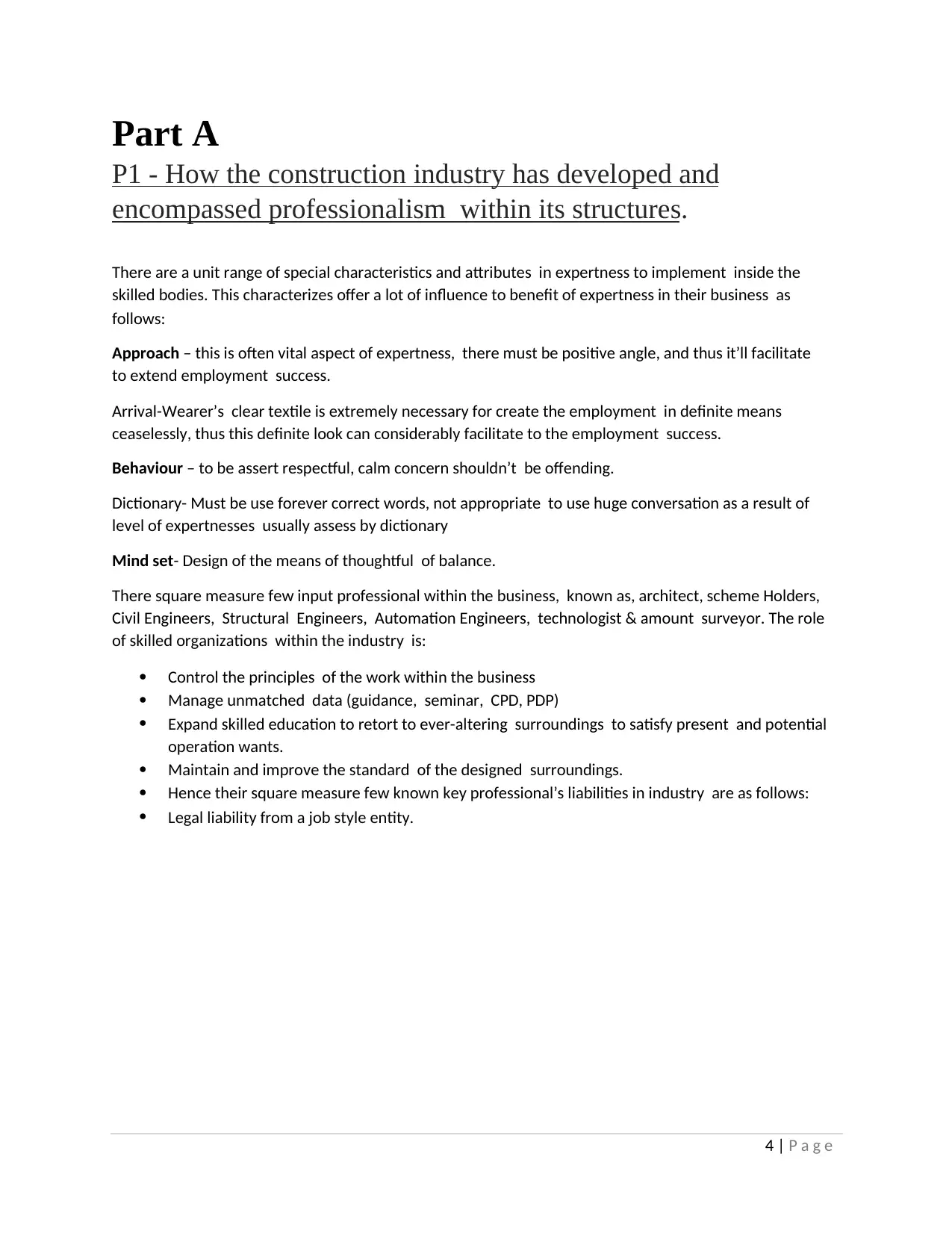
4 | P a g e
Part A
P1 - How the construction industry has developed and
encompassed professionalism within its structures.
There are a unit range of special characteristics and attributes in expertness to implement inside the
skilled bodies. This characterizes offer a lot of influence to benefit of expertness in their business as
follows:
Approach – this is often vital aspect of expertness, there must be positive angle, and thus it’ll facilitate
to extend employment success.
Arrival-Wearer’s clear textile is extremely necessary for create the employment in definite means
ceaselessly, thus this definite look can considerably facilitate to the employment success.
Behaviour – to be assert respectful, calm concern shouldn’t be offending.
Dictionary- Must be use forever correct words, not appropriate to use huge conversation as a result of
level of expertnesses usually assess by dictionary
Mind set- Design of the means of thoughtful of balance.
There square measure few input professional within the business, known as, architect, scheme Holders,
Civil Engineers, Structural Engineers, Automation Engineers, technologist & amount surveyor. The role
of skilled organizations within the industry is:
Control the principles of the work within the business
Manage unmatched data (guidance, seminar, CPD, PDP)
Expand skilled education to retort to ever-altering surroundings to satisfy present and potential
operation wants.
Maintain and improve the standard of the designed surroundings.
Hence their square measure few known key professional’s liabilities in industry are as follows:
Legal liability from a job style entity.
Part A
P1 - How the construction industry has developed and
encompassed professionalism within its structures.
There are a unit range of special characteristics and attributes in expertness to implement inside the
skilled bodies. This characterizes offer a lot of influence to benefit of expertness in their business as
follows:
Approach – this is often vital aspect of expertness, there must be positive angle, and thus it’ll facilitate
to extend employment success.
Arrival-Wearer’s clear textile is extremely necessary for create the employment in definite means
ceaselessly, thus this definite look can considerably facilitate to the employment success.
Behaviour – to be assert respectful, calm concern shouldn’t be offending.
Dictionary- Must be use forever correct words, not appropriate to use huge conversation as a result of
level of expertnesses usually assess by dictionary
Mind set- Design of the means of thoughtful of balance.
There square measure few input professional within the business, known as, architect, scheme Holders,
Civil Engineers, Structural Engineers, Automation Engineers, technologist & amount surveyor. The role
of skilled organizations within the industry is:
Control the principles of the work within the business
Manage unmatched data (guidance, seminar, CPD, PDP)
Expand skilled education to retort to ever-altering surroundings to satisfy present and potential
operation wants.
Maintain and improve the standard of the designed surroundings.
Hence their square measure few known key professional’s liabilities in industry are as follows:
Legal liability from a job style entity.
Paraphrase This Document
Need a fresh take? Get an instant paraphrase of this document with our AI Paraphraser
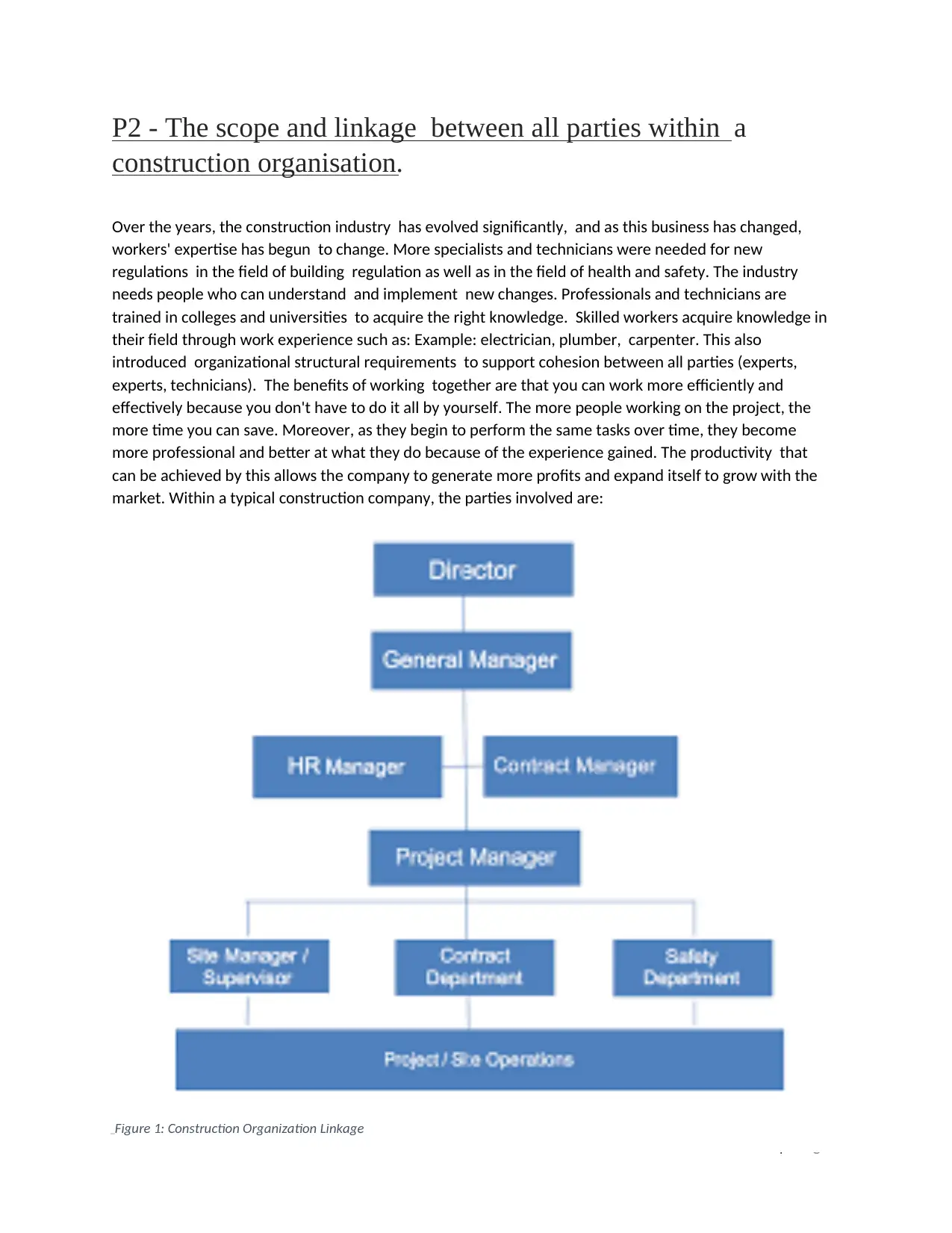
5 | P a g e
Figure 1: Construction Organization Linkage
P2 - The scope and linkage between all parties within a
construction organisation.
Over the years, the construction industry has evolved significantly, and as this business has changed,
workers' expertise has begun to change. More specialists and technicians were needed for new
regulations in the field of building regulation as well as in the field of health and safety. The industry
needs people who can understand and implement new changes. Professionals and technicians are
trained in colleges and universities to acquire the right knowledge. Skilled workers acquire knowledge in
their field through work experience such as: Example: electrician, plumber, carpenter. This also
introduced organizational structural requirements to support cohesion between all parties (experts,
experts, technicians). The benefits of working together are that you can work more efficiently and
effectively because you don't have to do it all by yourself. The more people working on the project, the
more time you can save. Moreover, as they begin to perform the same tasks over time, they become
more professional and better at what they do because of the experience gained. The productivity that
can be achieved by this allows the company to generate more profits and expand itself to grow with the
market. Within a typical construction company, the parties involved are:
Figure 1: Construction Organization Linkage
P2 - The scope and linkage between all parties within a
construction organisation.
Over the years, the construction industry has evolved significantly, and as this business has changed,
workers' expertise has begun to change. More specialists and technicians were needed for new
regulations in the field of building regulation as well as in the field of health and safety. The industry
needs people who can understand and implement new changes. Professionals and technicians are
trained in colleges and universities to acquire the right knowledge. Skilled workers acquire knowledge in
their field through work experience such as: Example: electrician, plumber, carpenter. This also
introduced organizational structural requirements to support cohesion between all parties (experts,
experts, technicians). The benefits of working together are that you can work more efficiently and
effectively because you don't have to do it all by yourself. The more people working on the project, the
more time you can save. Moreover, as they begin to perform the same tasks over time, they become
more professional and better at what they do because of the experience gained. The productivity that
can be achieved by this allows the company to generate more profits and expand itself to grow with the
market. Within a typical construction company, the parties involved are:
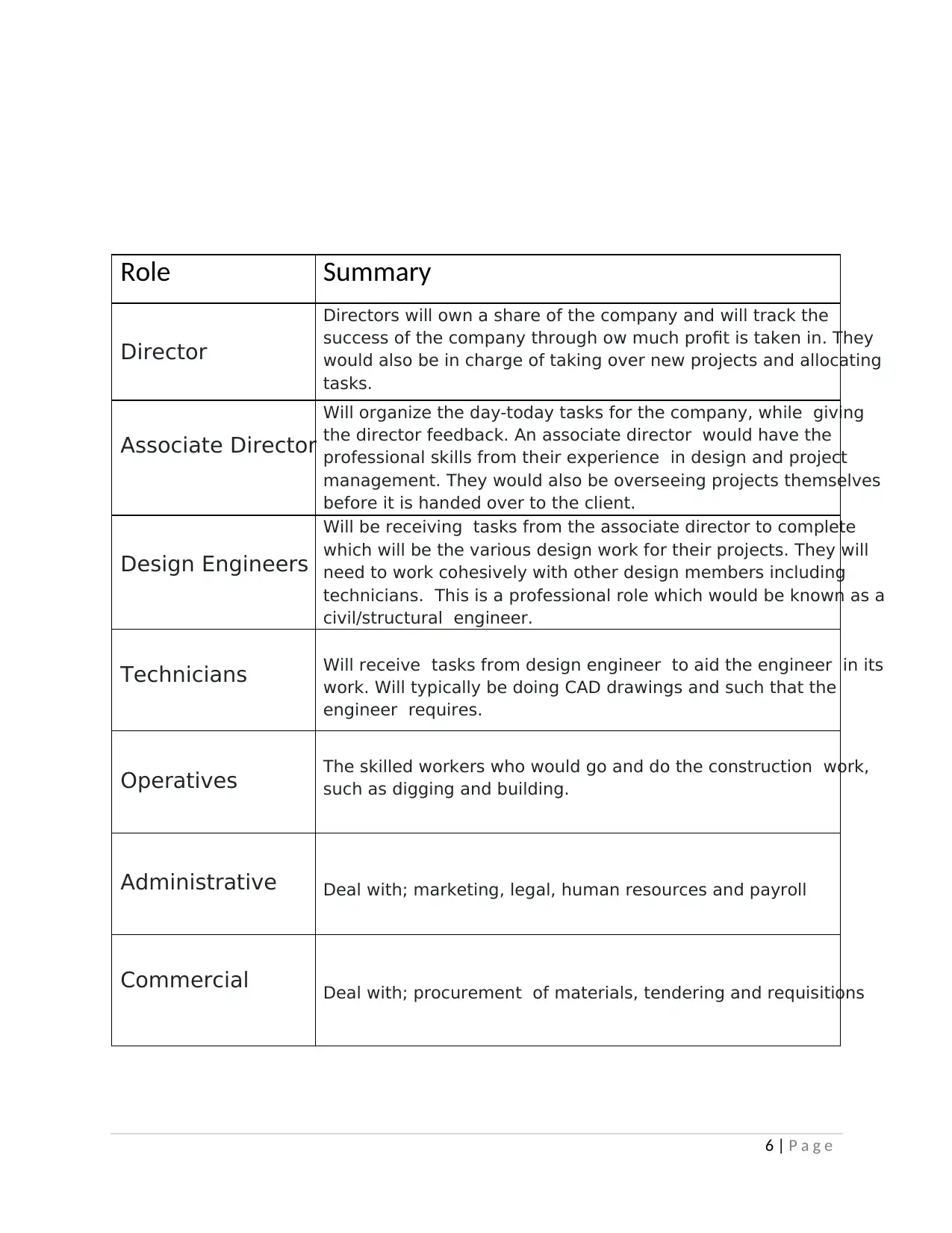
6 | P a g e
Role Summary
Director
Directors will own a share of the company and will track the
success of the company through ow much profit is taken in. They
would also be in charge of taking over new projects and allocating
tasks.
Associate Director
Will organize the day-today tasks for the company, while giving
the director feedback. An associate director would have the
professional skills from their experience in design and project
management. They would also be overseeing projects themselves
before it is handed over to the client.
Design Engineers
Will be receiving tasks from the associate director to complete
which will be the various design work for their projects. They will
need to work cohesively with other design members including
technicians. This is a professional role which would be known as a
civil/structural engineer.
Technicians Will receive tasks from design engineer to aid the engineer in its
work. Will typically be doing CAD drawings and such that the
engineer requires.
Operatives The skilled workers who would go and do the construction work,
such as digging and building.
Administrative Deal with; marketing, legal, human resources and payroll
Commercial Deal with; procurement of materials, tendering and requisitions
Role Summary
Director
Directors will own a share of the company and will track the
success of the company through ow much profit is taken in. They
would also be in charge of taking over new projects and allocating
tasks.
Associate Director
Will organize the day-today tasks for the company, while giving
the director feedback. An associate director would have the
professional skills from their experience in design and project
management. They would also be overseeing projects themselves
before it is handed over to the client.
Design Engineers
Will be receiving tasks from the associate director to complete
which will be the various design work for their projects. They will
need to work cohesively with other design members including
technicians. This is a professional role which would be known as a
civil/structural engineer.
Technicians Will receive tasks from design engineer to aid the engineer in its
work. Will typically be doing CAD drawings and such that the
engineer requires.
Operatives The skilled workers who would go and do the construction work,
such as digging and building.
Administrative Deal with; marketing, legal, human resources and payroll
Commercial Deal with; procurement of materials, tendering and requisitions
⊘ This is a preview!⊘
Do you want full access?
Subscribe today to unlock all pages.

Trusted by 1+ million students worldwide
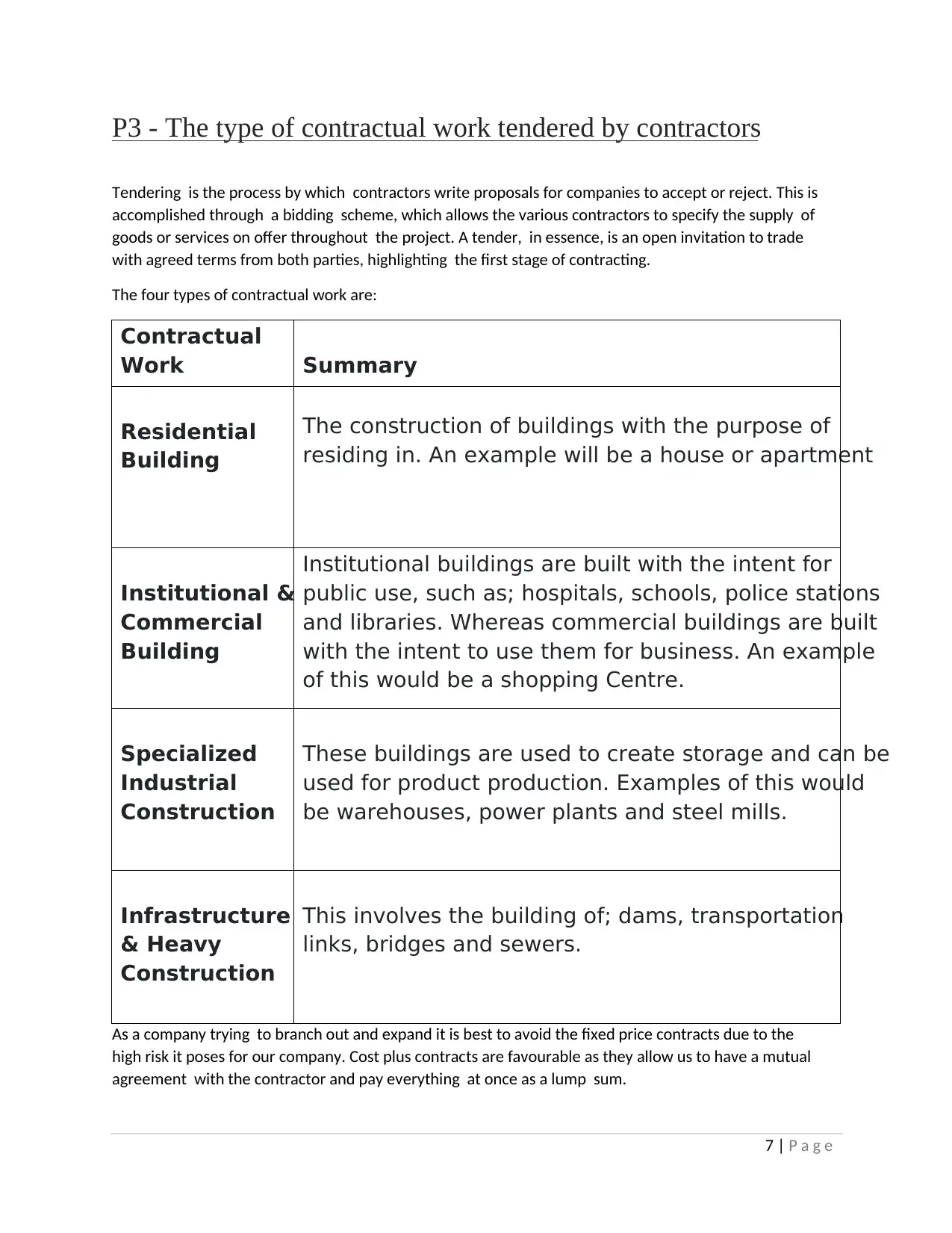
7 | P a g e
P3 - The type of contractual work tendered by contractors
Tendering is the process by which contractors write proposals for companies to accept or reject. This is
accomplished through a bidding scheme, which allows the various contractors to specify the supply of
goods or services on offer throughout the project. A tender, in essence, is an open invitation to trade
with agreed terms from both parties, highlighting the first stage of contracting.
The four types of contractual work are:
Contractual
Work Summary
Residential
Building
The construction of buildings with the purpose of
residing in. An example will be a house or apartment
Institutional &
Commercial
Building
Institutional buildings are built with the intent for
public use, such as; hospitals, schools, police stations
and libraries. Whereas commercial buildings are built
with the intent to use them for business. An example
of this would be a shopping Centre.
Specialized
Industrial
Construction
These buildings are used to create storage and can be
used for product production. Examples of this would
be warehouses, power plants and steel mills.
Infrastructure
& Heavy
Construction
This involves the building of; dams, transportation
links, bridges and sewers.
As a company trying to branch out and expand it is best to avoid the fixed price contracts due to the
high risk it poses for our company. Cost plus contracts are favourable as they allow us to have a mutual
agreement with the contractor and pay everything at once as a lump sum.
P3 - The type of contractual work tendered by contractors
Tendering is the process by which contractors write proposals for companies to accept or reject. This is
accomplished through a bidding scheme, which allows the various contractors to specify the supply of
goods or services on offer throughout the project. A tender, in essence, is an open invitation to trade
with agreed terms from both parties, highlighting the first stage of contracting.
The four types of contractual work are:
Contractual
Work Summary
Residential
Building
The construction of buildings with the purpose of
residing in. An example will be a house or apartment
Institutional &
Commercial
Building
Institutional buildings are built with the intent for
public use, such as; hospitals, schools, police stations
and libraries. Whereas commercial buildings are built
with the intent to use them for business. An example
of this would be a shopping Centre.
Specialized
Industrial
Construction
These buildings are used to create storage and can be
used for product production. Examples of this would
be warehouses, power plants and steel mills.
Infrastructure
& Heavy
Construction
This involves the building of; dams, transportation
links, bridges and sewers.
As a company trying to branch out and expand it is best to avoid the fixed price contracts due to the
high risk it poses for our company. Cost plus contracts are favourable as they allow us to have a mutual
agreement with the contractor and pay everything at once as a lump sum.
Paraphrase This Document
Need a fresh take? Get an instant paraphrase of this document with our AI Paraphraser
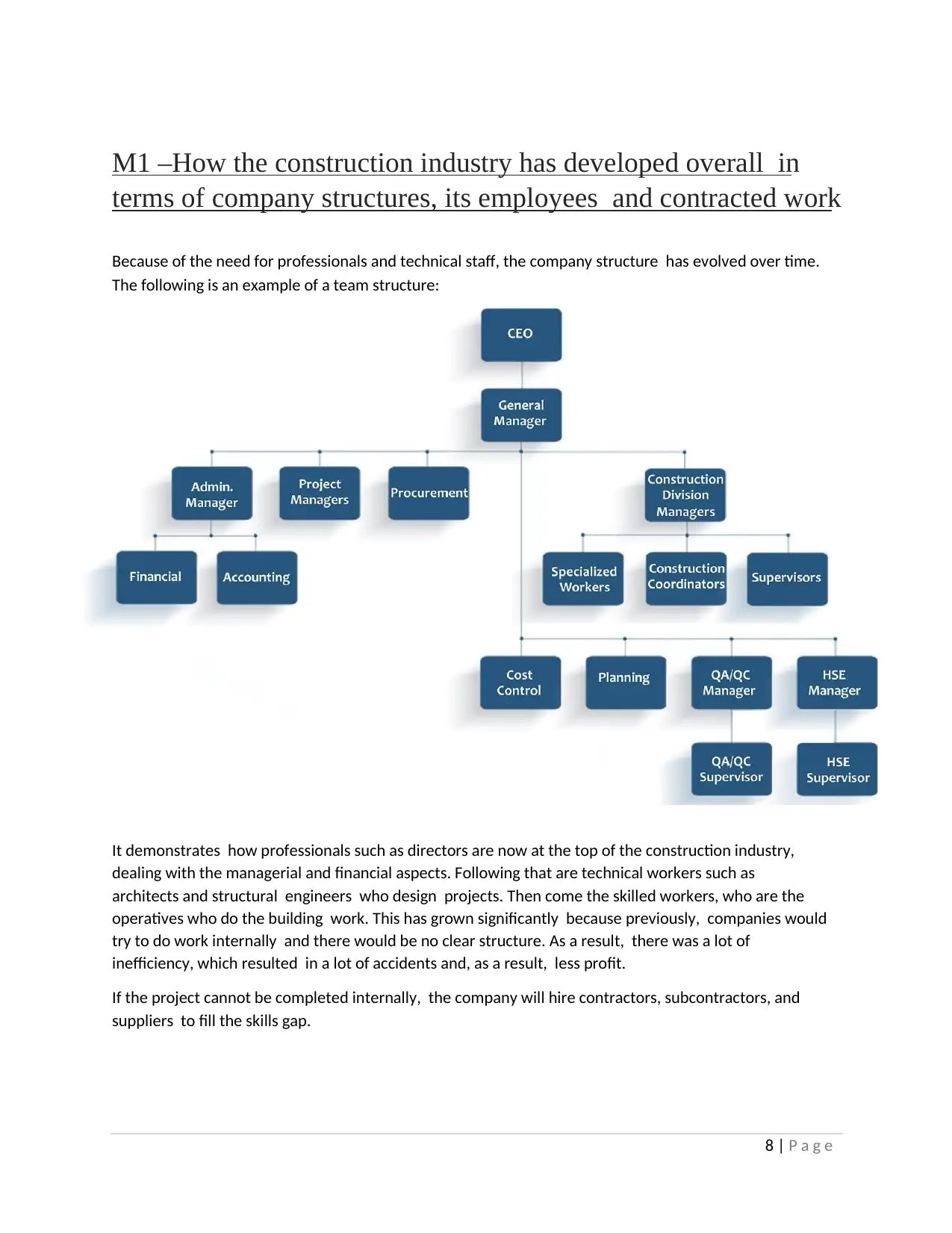
8 | P a g e
M1 –How the construction industry has developed overall in
terms of company structures, its employees and contracted work
Because of the need for professionals and technical staff, the company structure has evolved over time.
The following is an example of a team structure:
It demonstrates how professionals such as directors are now at the top of the construction industry,
dealing with the managerial and financial aspects. Following that are technical workers such as
architects and structural engineers who design projects. Then come the skilled workers, who are the
operatives who do the building work. This has grown significantly because previously, companies would
try to do work internally and there would be no clear structure. As a result, there was a lot of
inefficiency, which resulted in a lot of accidents and, as a result, less profit.
If the project cannot be completed internally, the company will hire contractors, subcontractors, and
suppliers to fill the skills gap.
M1 –How the construction industry has developed overall in
terms of company structures, its employees and contracted work
Because of the need for professionals and technical staff, the company structure has evolved over time.
The following is an example of a team structure:
It demonstrates how professionals such as directors are now at the top of the construction industry,
dealing with the managerial and financial aspects. Following that are technical workers such as
architects and structural engineers who design projects. Then come the skilled workers, who are the
operatives who do the building work. This has grown significantly because previously, companies would
try to do work internally and there would be no clear structure. As a result, there was a lot of
inefficiency, which resulted in a lot of accidents and, as a result, less profit.
If the project cannot be completed internally, the company will hire contractors, subcontractors, and
suppliers to fill the skills gap.
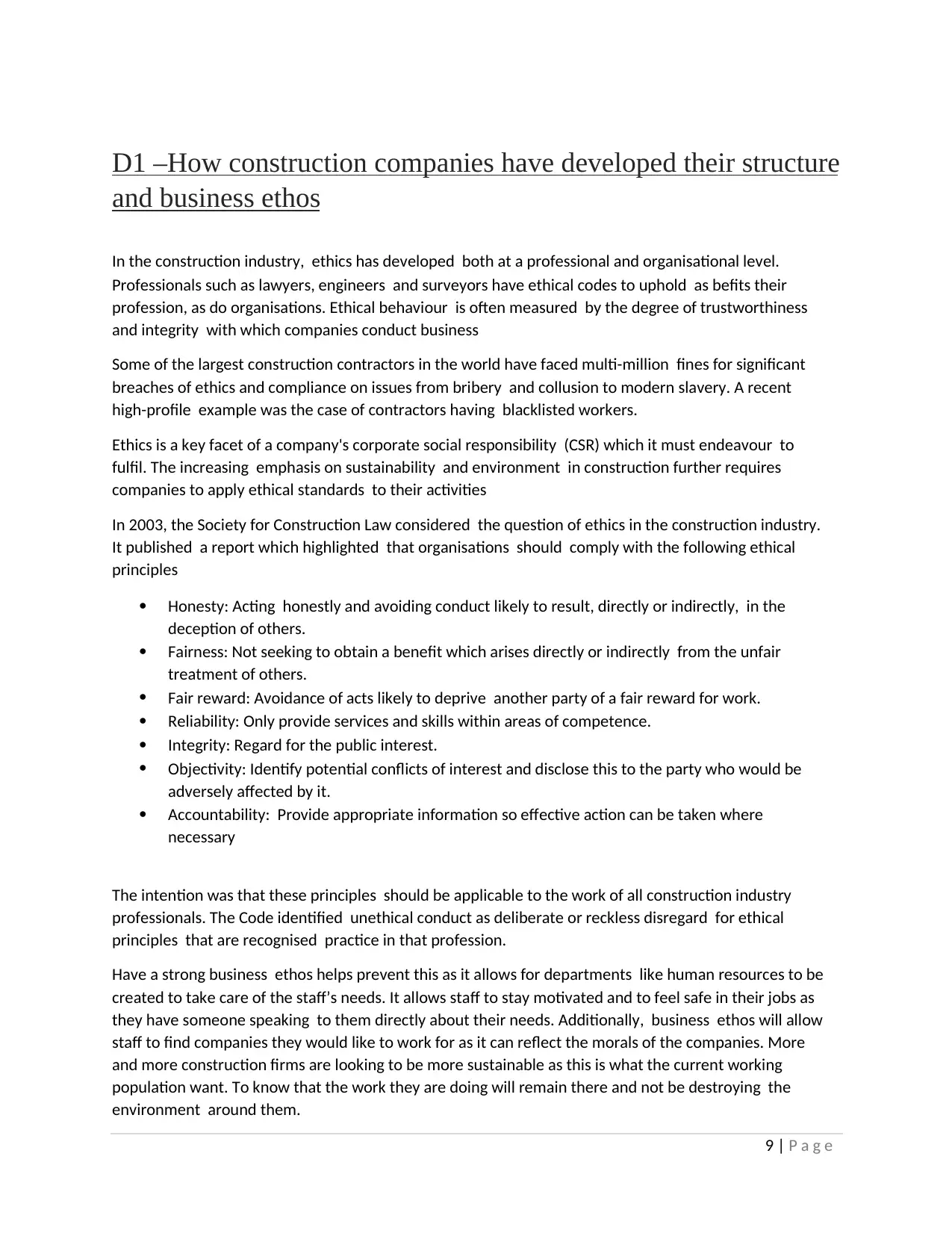
9 | P a g e
D1 –How construction companies have developed their structure
and business ethos
In the construction industry, ethics has developed both at a professional and organisational level.
Professionals such as lawyers, engineers and surveyors have ethical codes to uphold as befits their
profession, as do organisations. Ethical behaviour is often measured by the degree of trustworthiness
and integrity with which companies conduct business
Some of the largest construction contractors in the world have faced multi-million fines for significant
breaches of ethics and compliance on issues from bribery and collusion to modern slavery. A recent
high-profile example was the case of contractors having blacklisted workers.
Ethics is a key facet of a company's corporate social responsibility (CSR) which it must endeavour to
fulfil. The increasing emphasis on sustainability and environment in construction further requires
companies to apply ethical standards to their activities
In 2003, the Society for Construction Law considered the question of ethics in the construction industry.
It published a report which highlighted that organisations should comply with the following ethical
principles
Honesty: Acting honestly and avoiding conduct likely to result, directly or indirectly, in the
deception of others.
Fairness: Not seeking to obtain a benefit which arises directly or indirectly from the unfair
treatment of others.
Fair reward: Avoidance of acts likely to deprive another party of a fair reward for work.
Reliability: Only provide services and skills within areas of competence.
Integrity: Regard for the public interest.
Objectivity: Identify potential conflicts of interest and disclose this to the party who would be
adversely affected by it.
Accountability: Provide appropriate information so effective action can be taken where
necessary
The intention was that these principles should be applicable to the work of all construction industry
professionals. The Code identified unethical conduct as deliberate or reckless disregard for ethical
principles that are recognised practice in that profession.
Have a strong business ethos helps prevent this as it allows for departments like human resources to be
created to take care of the staff’s needs. It allows staff to stay motivated and to feel safe in their jobs as
they have someone speaking to them directly about their needs. Additionally, business ethos will allow
staff to find companies they would like to work for as it can reflect the morals of the companies. More
and more construction firms are looking to be more sustainable as this is what the current working
population want. To know that the work they are doing will remain there and not be destroying the
environment around them.
D1 –How construction companies have developed their structure
and business ethos
In the construction industry, ethics has developed both at a professional and organisational level.
Professionals such as lawyers, engineers and surveyors have ethical codes to uphold as befits their
profession, as do organisations. Ethical behaviour is often measured by the degree of trustworthiness
and integrity with which companies conduct business
Some of the largest construction contractors in the world have faced multi-million fines for significant
breaches of ethics and compliance on issues from bribery and collusion to modern slavery. A recent
high-profile example was the case of contractors having blacklisted workers.
Ethics is a key facet of a company's corporate social responsibility (CSR) which it must endeavour to
fulfil. The increasing emphasis on sustainability and environment in construction further requires
companies to apply ethical standards to their activities
In 2003, the Society for Construction Law considered the question of ethics in the construction industry.
It published a report which highlighted that organisations should comply with the following ethical
principles
Honesty: Acting honestly and avoiding conduct likely to result, directly or indirectly, in the
deception of others.
Fairness: Not seeking to obtain a benefit which arises directly or indirectly from the unfair
treatment of others.
Fair reward: Avoidance of acts likely to deprive another party of a fair reward for work.
Reliability: Only provide services and skills within areas of competence.
Integrity: Regard for the public interest.
Objectivity: Identify potential conflicts of interest and disclose this to the party who would be
adversely affected by it.
Accountability: Provide appropriate information so effective action can be taken where
necessary
The intention was that these principles should be applicable to the work of all construction industry
professionals. The Code identified unethical conduct as deliberate or reckless disregard for ethical
principles that are recognised practice in that profession.
Have a strong business ethos helps prevent this as it allows for departments like human resources to be
created to take care of the staff’s needs. It allows staff to stay motivated and to feel safe in their jobs as
they have someone speaking to them directly about their needs. Additionally, business ethos will allow
staff to find companies they would like to work for as it can reflect the morals of the companies. More
and more construction firms are looking to be more sustainable as this is what the current working
population want. To know that the work they are doing will remain there and not be destroying the
environment around them.
⊘ This is a preview!⊘
Do you want full access?
Subscribe today to unlock all pages.

Trusted by 1+ million students worldwide
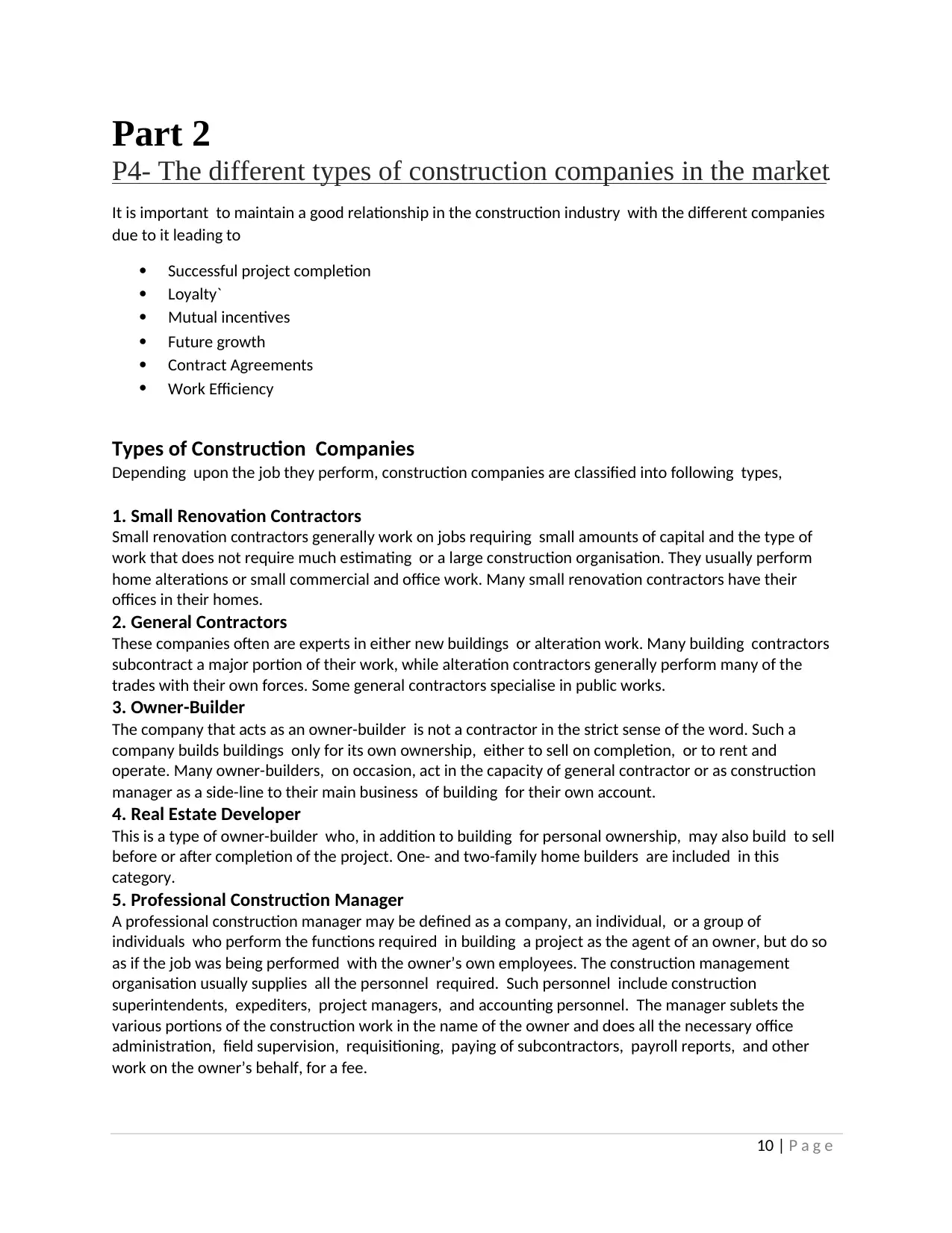
10 | P a g e
Part 2
P4- The different types of construction companies in the market.
It is important to maintain a good relationship in the construction industry with the different companies
due to it leading to
Successful project completion
Loyalty`
Mutual incentives
Future growth
Contract Agreements
Work Efficiency
Types of Construction Companies
Depending upon the job they perform, construction companies are classified into following types,
1. Small Renovation Contractors
Small renovation contractors generally work on jobs requiring small amounts of capital and the type of
work that does not require much estimating or a large construction organisation. They usually perform
home alterations or small commercial and office work. Many small renovation contractors have their
offices in their homes.
2. General Contractors
These companies often are experts in either new buildings or alteration work. Many building contractors
subcontract a major portion of their work, while alteration contractors generally perform many of the
trades with their own forces. Some general contractors specialise in public works.
3. Owner-Builder
The company that acts as an owner-builder is not a contractor in the strict sense of the word. Such a
company builds buildings only for its own ownership, either to sell on completion, or to rent and
operate. Many owner-builders, on occasion, act in the capacity of general contractor or as construction
manager as a side-line to their main business of building for their own account.
4. Real Estate Developer
This is a type of owner-builder who, in addition to building for personal ownership, may also build to sell
before or after completion of the project. One- and two-family home builders are included in this
category.
5. Professional Construction Manager
A professional construction manager may be defined as a company, an individual, or a group of
individuals who perform the functions required in building a project as the agent of an owner, but do so
as if the job was being performed with the owner’s own employees. The construction management
organisation usually supplies all the personnel required. Such personnel include construction
superintendents, expediters, project managers, and accounting personnel. The manager sublets the
various portions of the construction work in the name of the owner and does all the necessary office
administration, field supervision, requisitioning, paying of subcontractors, payroll reports, and other
work on the owner’s behalf, for a fee.
Part 2
P4- The different types of construction companies in the market.
It is important to maintain a good relationship in the construction industry with the different companies
due to it leading to
Successful project completion
Loyalty`
Mutual incentives
Future growth
Contract Agreements
Work Efficiency
Types of Construction Companies
Depending upon the job they perform, construction companies are classified into following types,
1. Small Renovation Contractors
Small renovation contractors generally work on jobs requiring small amounts of capital and the type of
work that does not require much estimating or a large construction organisation. They usually perform
home alterations or small commercial and office work. Many small renovation contractors have their
offices in their homes.
2. General Contractors
These companies often are experts in either new buildings or alteration work. Many building contractors
subcontract a major portion of their work, while alteration contractors generally perform many of the
trades with their own forces. Some general contractors specialise in public works.
3. Owner-Builder
The company that acts as an owner-builder is not a contractor in the strict sense of the word. Such a
company builds buildings only for its own ownership, either to sell on completion, or to rent and
operate. Many owner-builders, on occasion, act in the capacity of general contractor or as construction
manager as a side-line to their main business of building for their own account.
4. Real Estate Developer
This is a type of owner-builder who, in addition to building for personal ownership, may also build to sell
before or after completion of the project. One- and two-family home builders are included in this
category.
5. Professional Construction Manager
A professional construction manager may be defined as a company, an individual, or a group of
individuals who perform the functions required in building a project as the agent of an owner, but do so
as if the job was being performed with the owner’s own employees. The construction management
organisation usually supplies all the personnel required. Such personnel include construction
superintendents, expediters, project managers, and accounting personnel. The manager sublets the
various portions of the construction work in the name of the owner and does all the necessary office
administration, field supervision, requisitioning, paying of subcontractors, payroll reports, and other
work on the owner’s behalf, for a fee.
Paraphrase This Document
Need a fresh take? Get an instant paraphrase of this document with our AI Paraphraser
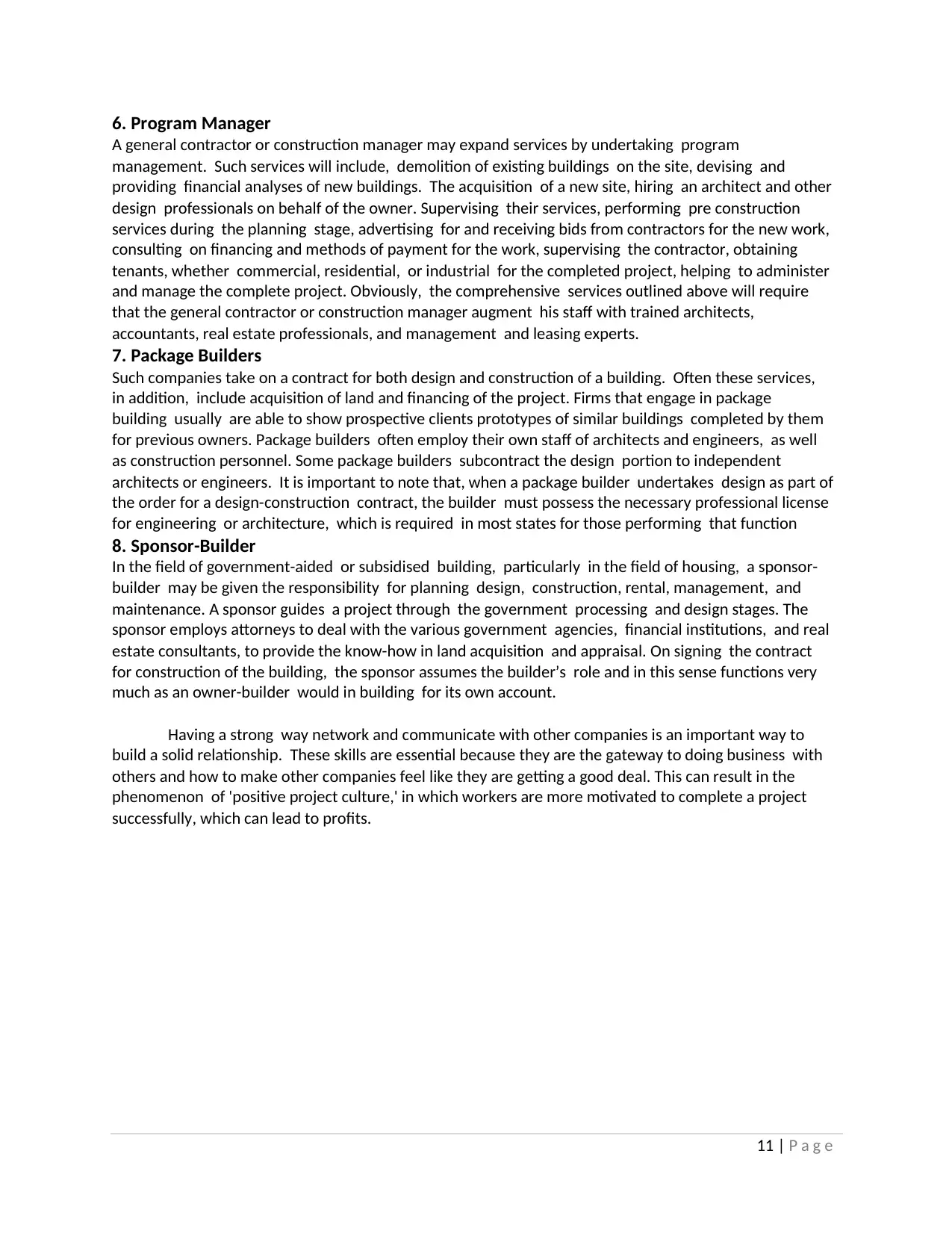
11 | P a g e
6. Program Manager
A general contractor or construction manager may expand services by undertaking program
management. Such services will include, demolition of existing buildings on the site, devising and
providing financial analyses of new buildings. The acquisition of a new site, hiring an architect and other
design professionals on behalf of the owner. Supervising their services, performing pre construction
services during the planning stage, advertising for and receiving bids from contractors for the new work,
consulting on financing and methods of payment for the work, supervising the contractor, obtaining
tenants, whether commercial, residential, or industrial for the completed project, helping to administer
and manage the complete project. Obviously, the comprehensive services outlined above will require
that the general contractor or construction manager augment his staff with trained architects,
accountants, real estate professionals, and management and leasing experts.
7. Package Builders
Such companies take on a contract for both design and construction of a building. Often these services,
in addition, include acquisition of land and financing of the project. Firms that engage in package
building usually are able to show prospective clients prototypes of similar buildings completed by them
for previous owners. Package builders often employ their own staff of architects and engineers, as well
as construction personnel. Some package builders subcontract the design portion to independent
architects or engineers. It is important to note that, when a package builder undertakes design as part of
the order for a design-construction contract, the builder must possess the necessary professional license
for engineering or architecture, which is required in most states for those performing that function
8. Sponsor-Builder
In the field of government-aided or subsidised building, particularly in the field of housing, a sponsor-
builder may be given the responsibility for planning design, construction, rental, management, and
maintenance. A sponsor guides a project through the government processing and design stages. The
sponsor employs attorneys to deal with the various government agencies, financial institutions, and real
estate consultants, to provide the know-how in land acquisition and appraisal. On signing the contract
for construction of the building, the sponsor assumes the builder’s role and in this sense functions very
much as an owner-builder would in building for its own account.
Having a strong way network and communicate with other companies is an important way to
build a solid relationship. These skills are essential because they are the gateway to doing business with
others and how to make other companies feel like they are getting a good deal. This can result in the
phenomenon of 'positive project culture,' in which workers are more motivated to complete a project
successfully, which can lead to profits.
6. Program Manager
A general contractor or construction manager may expand services by undertaking program
management. Such services will include, demolition of existing buildings on the site, devising and
providing financial analyses of new buildings. The acquisition of a new site, hiring an architect and other
design professionals on behalf of the owner. Supervising their services, performing pre construction
services during the planning stage, advertising for and receiving bids from contractors for the new work,
consulting on financing and methods of payment for the work, supervising the contractor, obtaining
tenants, whether commercial, residential, or industrial for the completed project, helping to administer
and manage the complete project. Obviously, the comprehensive services outlined above will require
that the general contractor or construction manager augment his staff with trained architects,
accountants, real estate professionals, and management and leasing experts.
7. Package Builders
Such companies take on a contract for both design and construction of a building. Often these services,
in addition, include acquisition of land and financing of the project. Firms that engage in package
building usually are able to show prospective clients prototypes of similar buildings completed by them
for previous owners. Package builders often employ their own staff of architects and engineers, as well
as construction personnel. Some package builders subcontract the design portion to independent
architects or engineers. It is important to note that, when a package builder undertakes design as part of
the order for a design-construction contract, the builder must possess the necessary professional license
for engineering or architecture, which is required in most states for those performing that function
8. Sponsor-Builder
In the field of government-aided or subsidised building, particularly in the field of housing, a sponsor-
builder may be given the responsibility for planning design, construction, rental, management, and
maintenance. A sponsor guides a project through the government processing and design stages. The
sponsor employs attorneys to deal with the various government agencies, financial institutions, and real
estate consultants, to provide the know-how in land acquisition and appraisal. On signing the contract
for construction of the building, the sponsor assumes the builder’s role and in this sense functions very
much as an owner-builder would in building for its own account.
Having a strong way network and communicate with other companies is an important way to
build a solid relationship. These skills are essential because they are the gateway to doing business with
others and how to make other companies feel like they are getting a good deal. This can result in the
phenomenon of 'positive project culture,' in which workers are more motivated to complete a project
successfully, which can lead to profits.
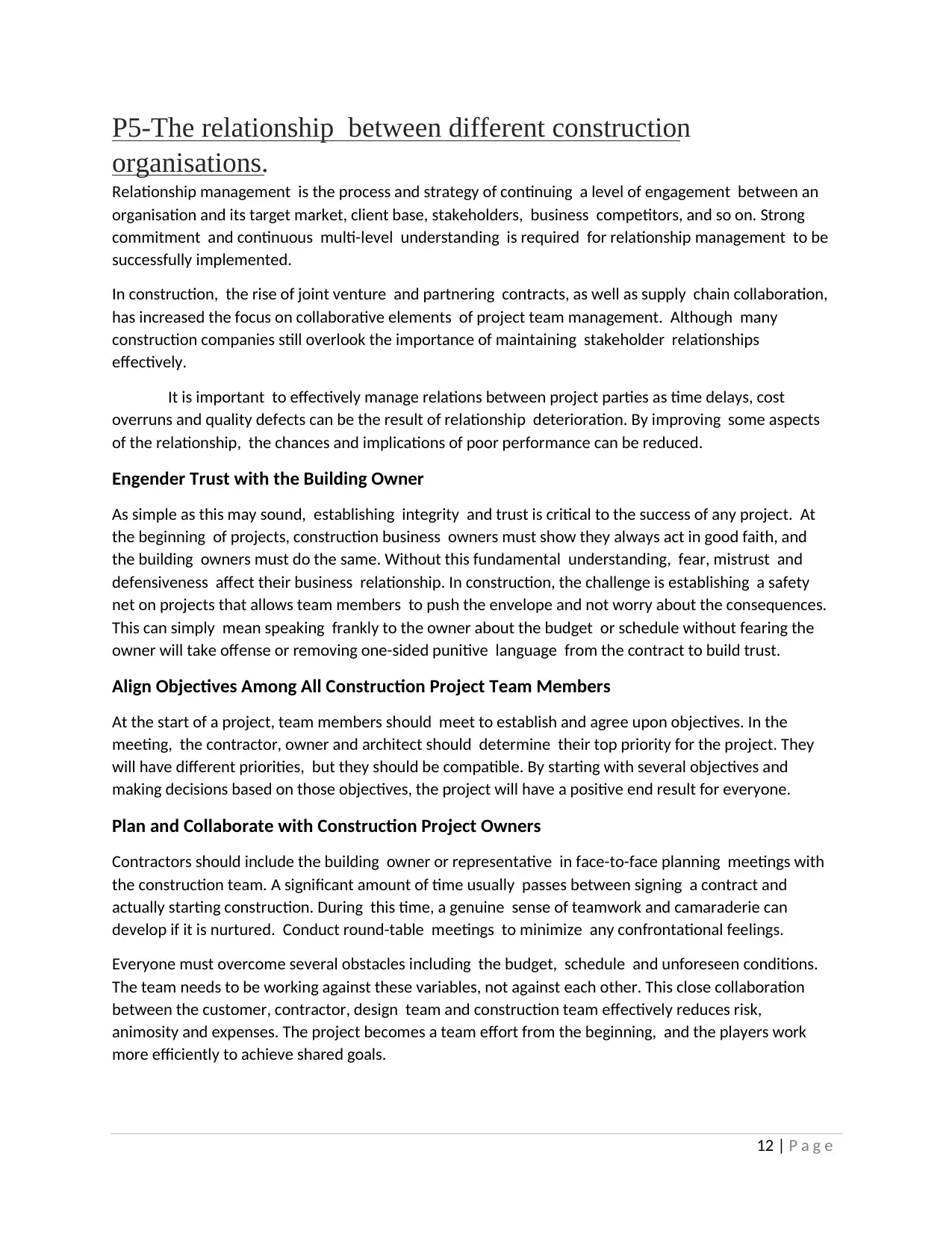
12 | P a g e
P5-The relationship between different construction
organisations.
Relationship management is the process and strategy of continuing a level of engagement between an
organisation and its target market, client base, stakeholders, business competitors, and so on. Strong
commitment and continuous multi-level understanding is required for relationship management to be
successfully implemented.
In construction, the rise of joint venture and partnering contracts, as well as supply chain collaboration,
has increased the focus on collaborative elements of project team management. Although many
construction companies still overlook the importance of maintaining stakeholder relationships
effectively.
It is important to effectively manage relations between project parties as time delays, cost
overruns and quality defects can be the result of relationship deterioration. By improving some aspects
of the relationship, the chances and implications of poor performance can be reduced.
Engender Trust with the Building Owner
As simple as this may sound, establishing integrity and trust is critical to the success of any project. At
the beginning of projects, construction business owners must show they always act in good faith, and
the building owners must do the same. Without this fundamental understanding, fear, mistrust and
defensiveness affect their business relationship. In construction, the challenge is establishing a safety
net on projects that allows team members to push the envelope and not worry about the consequences.
This can simply mean speaking frankly to the owner about the budget or schedule without fearing the
owner will take offense or removing one-sided punitive language from the contract to build trust.
Align Objectives Among All Construction Project Team Members
At the start of a project, team members should meet to establish and agree upon objectives. In the
meeting, the contractor, owner and architect should determine their top priority for the project. They
will have different priorities, but they should be compatible. By starting with several objectives and
making decisions based on those objectives, the project will have a positive end result for everyone.
Plan and Collaborate with Construction Project Owners
Contractors should include the building owner or representative in face-to-face planning meetings with
the construction team. A significant amount of time usually passes between signing a contract and
actually starting construction. During this time, a genuine sense of teamwork and camaraderie can
develop if it is nurtured. Conduct round-table meetings to minimize any confrontational feelings.
Everyone must overcome several obstacles including the budget, schedule and unforeseen conditions.
The team needs to be working against these variables, not against each other. This close collaboration
between the customer, contractor, design team and construction team effectively reduces risk,
animosity and expenses. The project becomes a team effort from the beginning, and the players work
more efficiently to achieve shared goals.
P5-The relationship between different construction
organisations.
Relationship management is the process and strategy of continuing a level of engagement between an
organisation and its target market, client base, stakeholders, business competitors, and so on. Strong
commitment and continuous multi-level understanding is required for relationship management to be
successfully implemented.
In construction, the rise of joint venture and partnering contracts, as well as supply chain collaboration,
has increased the focus on collaborative elements of project team management. Although many
construction companies still overlook the importance of maintaining stakeholder relationships
effectively.
It is important to effectively manage relations between project parties as time delays, cost
overruns and quality defects can be the result of relationship deterioration. By improving some aspects
of the relationship, the chances and implications of poor performance can be reduced.
Engender Trust with the Building Owner
As simple as this may sound, establishing integrity and trust is critical to the success of any project. At
the beginning of projects, construction business owners must show they always act in good faith, and
the building owners must do the same. Without this fundamental understanding, fear, mistrust and
defensiveness affect their business relationship. In construction, the challenge is establishing a safety
net on projects that allows team members to push the envelope and not worry about the consequences.
This can simply mean speaking frankly to the owner about the budget or schedule without fearing the
owner will take offense or removing one-sided punitive language from the contract to build trust.
Align Objectives Among All Construction Project Team Members
At the start of a project, team members should meet to establish and agree upon objectives. In the
meeting, the contractor, owner and architect should determine their top priority for the project. They
will have different priorities, but they should be compatible. By starting with several objectives and
making decisions based on those objectives, the project will have a positive end result for everyone.
Plan and Collaborate with Construction Project Owners
Contractors should include the building owner or representative in face-to-face planning meetings with
the construction team. A significant amount of time usually passes between signing a contract and
actually starting construction. During this time, a genuine sense of teamwork and camaraderie can
develop if it is nurtured. Conduct round-table meetings to minimize any confrontational feelings.
Everyone must overcome several obstacles including the budget, schedule and unforeseen conditions.
The team needs to be working against these variables, not against each other. This close collaboration
between the customer, contractor, design team and construction team effectively reduces risk,
animosity and expenses. The project becomes a team effort from the beginning, and the players work
more efficiently to achieve shared goals.
⊘ This is a preview!⊘
Do you want full access?
Subscribe today to unlock all pages.

Trusted by 1+ million students worldwide
1 out of 28
Related Documents
Your All-in-One AI-Powered Toolkit for Academic Success.
+13062052269
info@desklib.com
Available 24*7 on WhatsApp / Email
![[object Object]](/_next/static/media/star-bottom.7253800d.svg)
Unlock your academic potential
Copyright © 2020–2025 A2Z Services. All Rights Reserved. Developed and managed by ZUCOL.





